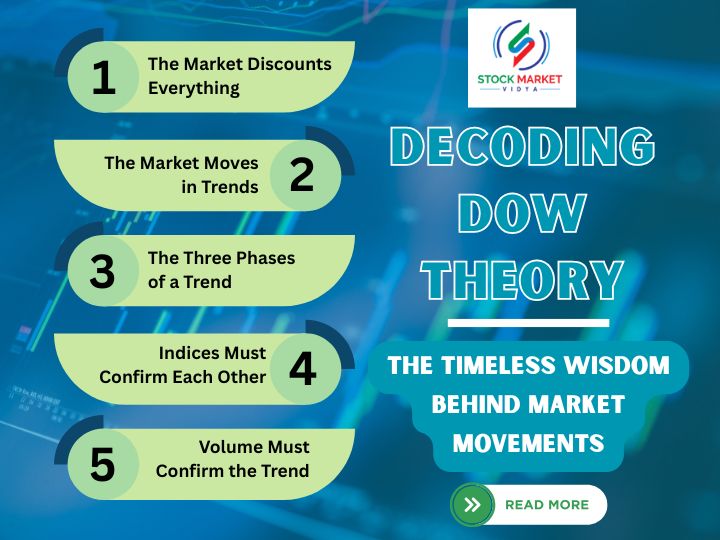An Exclusive Insight from Stock Market Vidya, Nagpur
Why Dow Theory Still Matters in 2025
Markets change. Technology evolves. But some principles remain rock solid. One such principle is Dow Theory—a classic framework that has stood the test of time in decoding market movements. If you’re someone seriously considering a career in trading or investing, or if you’re looking to build deep technical analysis foundations, understanding Dow Theory is not optional—it’s essential.
At Stock Market Vidya, Nagpur, we’ve trained thousands of aspiring traders and investors who now confidently analyze markets using timeless tools like Dow Theory. Our commitment to offering the best share market classes in Nagpur includes breaking down these complex theories into easy, actionable insights.
So, whether you’re searching for a stock market course, exploring options for share market training, or simply googling “share market course near me,” this article will give you a solid, structured, and in-depth understanding of Dow Theory—written in a completely fresh voice and perspective.
The Origin Story: Dow Theory’s Historical Roots
Dow Theory isn’t just another trading method—it’s the bedrock of technical analysis. Formulated by Charles H. Dow, co-founder of Dow Jones & Company and the first editor of the Wall Street Journal, this theory was initially introduced through a series of editorials rather than a single publication.
Though Charles Dow passed away in 1902, his theories were later organized and expanded by William Peter Hamilton, Robert Rhea, and others, shaping what we now know as “Dow Theory.”
Why is this important to a modern trader?
Because understanding where a theory comes from helps you respect its relevance even in today’s fast-paced trading ecosystem.
The Backbone of Dow Theory: The 6 Core Tenets
Let’s get into the heart of it. Dow Theory isn’t a single concept—it’s a combination of six principles that work together to interpret market movements. At Stock Market Vidya, we emphasize learning the ‘why’ behind every ‘what,’ and these six tenets are explained with real-world implications in our share market training sessions.
1. The Market Discounts Everything
This is perhaps the most powerful idea. It means that all known and unknown information—economic, political, psychological—is already reflected in the price.
In other words, price is the final truth-teller.
This concept is still relevant in 2025, especially when we see how quickly global news impacts markets. Whether it’s an interest rate hike in the US or geopolitical tension in Asia, the Indian market reacts instantly—and that’s Dow’s first principle at play.
2. The Market Moves in Trends
Markets don’t move randomly. They move in trends: upward (bull), downward (bear), or sideways (consolidation). According to Dow, these trends can be classified into three types:
- Primary Trend: Long-term (lasting a year or more)
- Secondary Trend: Medium-term corrections or rallies within a primary trend
- Minor Trend: Short-term fluctuations, often daily or weekly
Learning to read these layers of trends can give you a sharp edge—something we focus deeply on in our stock market training modules.
3. The Three Phases of a Trend
Each primary trend is divided into three distinct psychological phases:
- Accumulation Phase: Smart money enters quietly.
- Public Participation Phase: Momentum picks up; retail investors join in.
- Distribution Phase: Smart money starts to exit; signs of topping appear.
Understanding these phases can help you anticipate the market, not just react to it. That’s the difference between guessing and analyzing—a core part of our share market course in Nagpur.
4. Indices Must Confirm Each Other
Dow based this theory on two indices—the Dow Jones Industrial Average (DJIA) and the Dow Jones Transportation Average (DJTA). For a trend to be valid, both should confirm each other.
In modern terms, this means cross-verifying signals. For instance, if Nifty is going up but Bank Nifty is lagging, be cautious. Divergence in key sectors can invalidate bullish signals.
This concept is deeply woven into our stock market course, especially in the modules related to intermarket analysis.
5. Volume Must Confirm the Trend
Price movement is powerful. But price with volume is unstoppable. Dow emphasized that volume should rise in the direction of the trend.
- In a bull market, volume should increase on rallies.
- In a bear market, volume should rise during declines.
Volume is the fuel that powers the engine. Ignoring it is like driving blindfolded.
At Stock Market Vidya, we teach how to use volume-based indicators like OBV, VWAP, and Accumulation/Distribution to strengthen your trend confirmation skills.
6. Trends Persist Until Clear Reversal Signals Appear
Don’t jump the gun. A trend continues until there’s an unmistakable sign of reversal.
This is where many traders go wrong. They try to pick tops and bottoms, only to be trapped. Dow Theory advises patience—wait for confirmation.
At our share market classes, we teach precise entry and exit strategies using Dow principles, along with stop-loss placements to manage risk effectively.
Dow Theory in Today’s Market: Still Relevant or Outdated?
Some traders feel that Dow Theory is outdated in the era of algorithmic trading and real-time data. But nothing could be farther from the truth.
In 2025, despite advanced tools and AI-based indicators, the psychology of market participants hasn’t changed. People still buy on hope and sell on fear. Trends still follow the same accumulation-distribution cycle. And volume still confirms conviction.
What Dow Theory offers is timeless market wisdom—a structured way to read price action, which you can blend with modern tools like candlestick analysis, RSI, MACD, etc.
That’s why we call it “the grammar of the stock market” at Stock Market Vidya, your destination for the best share market classes in Nagpur.
How We Teach Dow Theory Differently at Stock Market Vidya
You might find dozens of videos or articles online explaining Dow Theory. But here’s what sets us apart:
- Hands-on Chart Analysis: We decode real market charts using Dow principles during every class.
- Live Case Studies: Students analyze ongoing trends in Nifty, Bank Nifty, and top stocks using Dow concepts.
- Psychological Training: We connect Dow Theory phases with trader psychology for deeper insight.
- Multi-Timeframe Analysis: Learn how Dow principles apply to daily, weekly, and intraday charts.
If you’re searching for a stock market course near me that teaches you not just what to trade, but how to think, Stock Market Vidya is your answer.
Application of Dow Theory in Trading: Real-World Scenarios
Let’s apply what we’ve learned.
Scenario 1: Spotting a Bullish Breakout
You observe that Nifty has formed higher highs and higher lows (primary uptrend), and Bank Nifty confirms the move. Volume is increasing on up days, and RSI supports momentum. This is a classic Dow Theory confirmation.
Your action? Ride the trend till a lower high and lower low forms, with volume on the downside.
Scenario 2: Exit on Distribution Phase
A stock that rallied for months now shows sideways movement with declining volume. Price is unable to make new highs. Here’s your signal that the distribution phase might be underway. Time to exit or tighten stop-losses.
This real-time understanding is embedded in our share market classes, ensuring students learn by doing, not just listening.
Dow Theory + Modern Tools = Smarter Trading
Today’s market offers traders a powerful advantage—blending Dow Theory with:
- Price Action
- Moving Averages
- Candlestick Patterns
- MACD & RSI
- Volume Profile & Market Structure
This synergy helps you not just identify trends but also time your trades precisely. That’s the focus of our share market training—a well-rounded, practical, and logical approach to trading and investing.
Final Thoughts: Dow Theory Is the Foundation, Not the Finish Line
If you’re serious about understanding the DNA of the market, Dow Theory is your starting point. It’s not the flashiest strategy, but it’s foundational. Think of it like learning the alphabet before writing poetry.
And at Stock Market Vidya, we believe in building traders who can write their own success stories—because they know the alphabet of price movement inside out.
So, whether you’re a beginner searching for a stock market course in Nagpur or an intermediate trader wanting to level up, learning Dow Theory the right way can elevate your decision-making and risk management.
Ready to Learn the Right Way?
Enroll today in the best share market classes in Nagpur, where concepts like Dow Theory aren’t just taught—they’re lived, practiced, and mastered.
Contact: 9822718163, 8421893845
Website: www.stockmarketvidya.com
Let’s decode the market—one theory at a time.
Frequently Asked Questions (FAQs) About Dow Theory
Q1. What is Dow Theory in simple words?
Ans: Dow Theory is a method of analyzing the stock market using price movements and trends. It says that the market moves in trends—upward, downward, or sideways—and these trends continue until strong signals show they are reversing. It helps traders understand when to buy, hold, or sell based on market phases.
Q2. Who invented Dow Theory?
Ans: Dow Theory was developed by Charles H. Dow, the co-founder of the Dow Jones & Company and the first editor of The Wall Street Journal. After his death, it was later refined by William Peter Hamilton and Robert Rhea.
Q3. Why is Dow Theory important for stock market traders in India?
Ans: Dow Theory provides a clear framework for understanding how the market behaves. For Indian traders, especially those learning from share market classes or pursuing a stock market course in Nagpur, Dow Theory offers a strong foundation to identify trends, confirm signals, and manage risk smartly.
Q4. What are the main principles of Dow Theory?
Ans: There are six core principles in Dow Theory:
- The market discounts everything
- Market moves in trends
- Trends have three phases
- Indices must confirm each other
- Volume confirms the trend
- Trends persist until a reversal is confirmed
Q5. How does Dow Theory help in predicting market trends?
Ans: Dow Theory helps traders spot the beginning, middle, and end of market trends. By understanding phases like accumulation, public participation, and distribution, you can better judge when to enter or exit the market, improving your trade timing.
Q6. Is Dow Theory still relevant in 2025?
Ans: Absolutely. Even though technology has changed how we trade, the psychology of market participants remains the same. Dow Theory explains the emotional phases of the market, which are just as relevant today as they were 100 years ago.
Q7. Can beginners understand and apply Dow Theory?
Ans: Yes. Dow Theory is ideal for beginners when taught with practical examples. At Stock Market Vidya, part of our stock market training involves simplifying this theory so anyone can use it confidently, even with little experience.
Q8. Does Dow Theory work in intraday trading?
Ans: Dow Theory is mainly used for long-term and positional trading, but its principles can be adapted for intraday by using shorter timeframes and quick volume analysis. With the right guidance, even intraday traders can benefit from its insights.
Q9. How is Dow Theory different from other technical tools?
Ans: Most technical tools are indicators, while Dow Theory is a complete framework. It doesn’t just tell you when to trade—it explains why the market is behaving a certain way, based on trends and human behavior.
Q10. Where can I learn Dow Theory in Nagpur with real-time examples?
Ans: You can learn Dow Theory with hands-on market analysis and live chart reading at Stock Market Vidya, the institute known for the best share market classes in Nagpur. Contact us today at 9822718163 or 8421893845 to know more.


